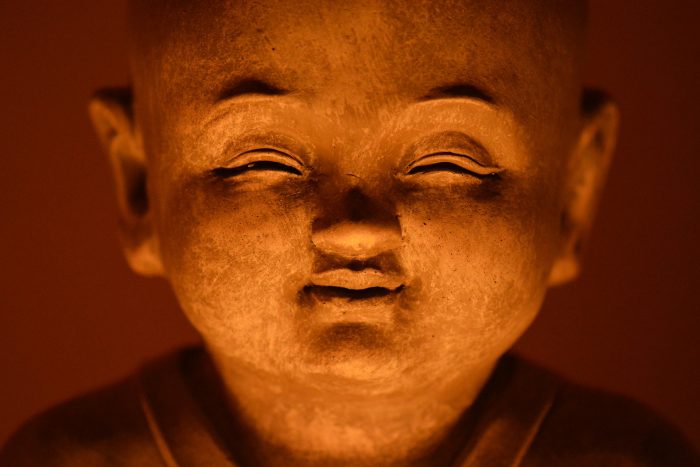I sat by my bay window while working.
This big window is my eyes to the outside world of lush green grass, mature maple, white oak, beech, and pine trees with chipmunks and birds playing hide and seek.
I raised my head in time to see the sky. The gold colours of the sun setting behind the line of trees, and the awe-inspiring moment reminded me nothing beautiful lasts forever, as the colours of the sky will melt in a few minutes.
The moment reminded me of my favourite poem from Robert Frost, “Nothing stays gold.” Here are the lines that remind me of the beauty of nature, small moments and breakthroughs, tears and laughter, living life—which is all short-lived.
Nature’s first green is gold,
Her hardest hue to hold.
Her early leaf’s a flower;
But only so an hour.
Then leaf subsides to leaf.
So Eden sank to grief,
So dawn goes down to day.
Nothing gold can stay.
The romantic and the dreamer in me wants to hold onto the gold, but the spirit in me knows that everything is transitory and in an ever-state of creation and destruction. Between the creation and destruction, there is a moment. This moment lasts shorter than the duration of the blink of an eye. This is what we called “now” or the “present moment.”
If I had a dollar for each time someone said, “Live in the now or the present,” I would be a millionaire by now. But, I have to wonder if it is really possible to live in the “now?” Does the “now” have a power that can release mere mortals like me to heights of living a joyous life?
To find the answer, I went back to the Rig Vedas, written between 1700-1100 BCE, which spoke about atoms. And, 2500 years ago, Buddha not only talked about the atoms (anu in Sanskrit), but also spoke on the splitting of atoms or, as we know them, the subatomic units (kalapas). He wrote all existence is made of kalapas, and each is dying out simultaneously as it becomes. Buddha further worded how his body appeared and disappeared in the lifespan of a blink of an eye, giving rise to anitya, or the impermanent nature of existence.
Science today has proven the constant arising and dissolution of atoms. In a few words, when atoms divide, the outcome is energy. And, all being in a continuous state of change, we are all but energy and vibration.
This was a breakthrough then and advancement now. If we are aware of the energy, vibration, and divisible nature of life within us, we will open the door to wisdom to be here now—the only moment that we know of, the single moment when the subatomic particle is arising and dissolving. This is the fleeting moment when we try to find life and live with satisfaction, fulfilment, and love, versus loneliness and emptiness.
I’d thought this moment is perhaps the purpose of the divine creation, until I was prodded with a challenging thought—living in the now is spiritual noise that does more harm than good in the real and practical world of daily life.
I was implored to dig deep and confront myself—am I living in the now? Can anyone live in the now?
By living in the present, are we asking ourselves to forget the past and the future?
Our past that included happiness, heights of success, lows in a job or a relationship, the grief of losing someone by death or choice in a relationship, childhood trauma, or even a collective trauma inflicted by the likes of worsening wars, and natural disasters is what made us and brought us to the “now.”
So, how can one bypass the past to live in the now—it would be unfair to who we are.
And what about the future? We all dream and plan for a financially secure future. Many even wishfully think financial success will translate into success in our relationships.
We fail to recognize that life does not let us avoid or forget anything until we learn our lessons. We are not put through hell for nothing.
There are times when we feel like we are walking on a live wire (aka trauma, grief, and loss). But to shape the future, we have to learn from the past and act in the “now.” Yes, we think of our past, but we do not have to live it again and again.
The harm is not that we think of our past or the future, but when we start living it. Our past happened—yesterday is gone and it cannot be returned. But we have the current still in our hands.
Let us begin to honour our journey and each other’s past. There is no deadline or a playbook for healing.
Yes, I am aware of my past, my grief, my trauma, but my inner work has brought me to a place where I refuse to give it a home in my head. I own my minefield of pain, and other times, it is like that small splinter in the finger that keeps bothering me. But I go ahead and find the tweezers to pull it out—my resolve to acknowledge, accept, and move forward at my own pace.
This is opposite to dissociation or avoidance of the past. Was it a journey to reach this place? Absolutely yes. Was it tears and blood? Hell yes. I want to grab my “now” because that’s all I am left with to act upon—the keyword here is to act versus avoid.
The same thought process applies to the future. One cannot keep on dreaming of the future if, in the “now,” we don’t act toward it. Again the word is to “act.”
Human life is never secured, so how can a future be? All we can do is to work in the “now” and live a life filled with passion for creating something that is closest to one’s heart—the kind of passion that can make one’s knees go weak and bring tears to the eyes.
So, I believe I may have an answer to this conundrum of living in the now—whether it is possible or not. Yes, live in the now because that’s all we have—like a bubble, this life will burst one day; we will have to unlearn the norms, the beliefs, the self-imposed limits to learn to catch the bubble before it pops. And while this bubble is still floating in the wind carelessly, let us consciously take our time with our journeys, do the inner work to address and heal our broken parts. But remember, even with the broken pieces, you are a whole individual.
On the spiritual side, when ancient texts and enlightened Buddha spoke of impermanence, it was an indication of the dissolving and arising of the atoms leaving us with one moment where there is creation in the “now.”
Scientifically, it has been proven the same.
Let’s not look into “living in the now” in any other way.
After all, nothing stays gold, just like the sunsets.
~


 Share on bsky
Share on bsky





Read 46 comments and reply